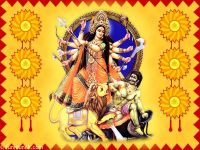 Article
Article
Ramyani mukherjee
|
|
|
| Voir son profil | Voir ses articles |
The magical Days of Durga Puja

Auteur : Ramyani Mukherjee
Note : 
Enquête : ->
Pays : Inde 
Lieu : kolkata
Langue : 
![]()

As the year with its twelve months, gradually passes on and nears the months of September and October, a spark of joy creeps into the hearts of all the people of West Bengal. Happiness fills their heart and they patiently await the arrival of their one major festival Durga Puja, with enthusiasm and excitement, thinking about all the fun they would have and how much they would enjoy during the six happy days of Durga Puja. During Durga Puja, the mighty goddess, Durga, is worshiped. Durga Puja is a festivity of Good (Ma Durga) winning over the evil (Maheshasoora the demon). It is a worship of power of Good which always wins over the bad.
The worship of Durga in the autumn ('Shorot') is the year's largest Hindu festival in West Bengal, Orissa, Tripura, Assam, Jharkhand and other parts of East India as well as in Bangladesh. According to local traditions and variations Puja means "worship," and Durga Puja is celebrated from the sixth to tenth day of the waxing moon in the month of 'Ashwin', which is the sixth month in the Bengali calendar. It may also be held in the following month, Kartik. The Pujas are held over a ten-day period, which is traditionally viewed as the coming of the married daughter, Durga, to her father, Himalaya's home. It is the most important festival in Bengal.
People of Bengal start their Puja shopping as early as August. They buy new clothes to wear during the six special days of Durga Puja. All the shops start giving discounts on garments, shoes, etc. People flock in huge numbers in the shopping malls and shops to buy their dresses and gifts for themselves or their relatives. This is a good time for all the businessmen and shopkeepers to make profit. The customers also get what they want at low prices for the Puja. The days of Durga Puja are a happy and memorable time for everyone.
Durga puja mood starts off with the Mahishasuramardini' – a radio programme that has been popular with the community since the 1950s. While earlier it used to be conducted live, later a recorded version began to be broadcast. Bengalis traditionally wake up at 4 in the morning on Mahalaya day to listen to the enchanting voice of the late Birendra Krishna Bhadra and the late Pankaj Kumar Mullick on All India Radio as they recited hymns from the scriptures from the Devi Mahatmyam or Chandi.
The days of fun and festivity start off with Shoshti, the day of arrival of Goddess Durga. Then follows the days of Saptami, Ashtami, Nabami and the day of farewell, Dashami.
Temporary structures called pandals are constructed to venerate the Goddess Durga. . In playgrounds, traffic circles, ponds, wherever space may be available, elaborate structures called pandals 'are set up, many with nearly a year's worth of planning behind them. The word pandal means a temporary structure, made of bamboo and cloth, which is used as a temporary temple for the purpose of the puja. While some of the pandals are simple structures, others are often elaborate works of art with themes that rely heavily on history, current affairs and sometimes pure imagination. The pandals are of diverse kinds. Some are made of simple, attractive cloths while some are even made of grains, wheat, chocolate wrappers, Horlicks bottles, etc, results of great imagination and hard work. In Kolkata alone more than ten thousand pandals are set up, all clamouring for the admiration and praise of the populace. The sculpture of the idol itself has evolved. The worship always depicts Durga with her four children, and occasionally two attendant deities and some banana-tree figures. The city is adorned with lights. The people wear their new dresses during the six happy days of the great festival when they go out in the evenings with their family and friends to look at all the pandals, the idols of Goddess Durga, and the lightings. They stay awake the entire night and visit pandals by feet or by car. The entire state springs to life and the streets are full of people, cars and glittering lights the entire night. Durga Puja in Bengal is a carnival, where people from all backgrounds, regardless of their religious beliefs, participate and enjoy themselves to the hilt. Fairs and carnivals are set up where children as well as adults enjoy rides in the Giant Wheel, Break Dance, etc. Food stalls are set up everywhere. Durga Puja is such a festival during which everyone is happy. It is also a happy moment for the poor ‘puchkawallas’, ‘bhelpuri sellers’, etc. as they get to make a lot of money, and also for the poor children and beggars who sit by the roadside and ask for money from people as the roads are crowded with people the entire day and night. And also not forgetting the pickpockets…they get a golden opportunity to pick people’s pockets and steal money and disappear in the crowd.
LOTS OF FUN. Immense enjoyment and merriment… but when the last day of the festival arrives-Bijoya Doshomi, everyone’s heart fills with sadness. They now have to bid farewell to Goddess Durga as she returns back. On that day the idol is taken for immersion in a procession amid loud chants of 'Bolo Durga mai-ki jai' (glory be to Mother Durga') and 'Aashchhe bochhor abar hobe' ('it will happen again next year') along with drumbeats and a merry dance to the river or water body where the idol is cast in the water symbolizing the departure of the deity to her home with her husband in the Himalayas. After this, in a tradition called Bijoya Doshomi, families visit each other and sweetmeats are offered to visitors. Doshomi means the ‘tenth day’ and bijoy means ‘victory’. Although this last day signifies the end of the festival, but all the happiness shared and experienced during these six special days remain glowing in people’s minds like glittering jewels whose shine will never fade. The people eagerly wait for the next Durga Puja which will again arrive the following year… doesn’t really matter if we have to wait for another 365 days.
Contexte NEOS : Nature et environnement
Thèmes
Social, culture et mode de vie
Culture - Festivals & cérémonies
Religion

